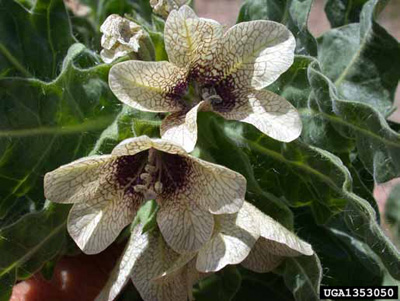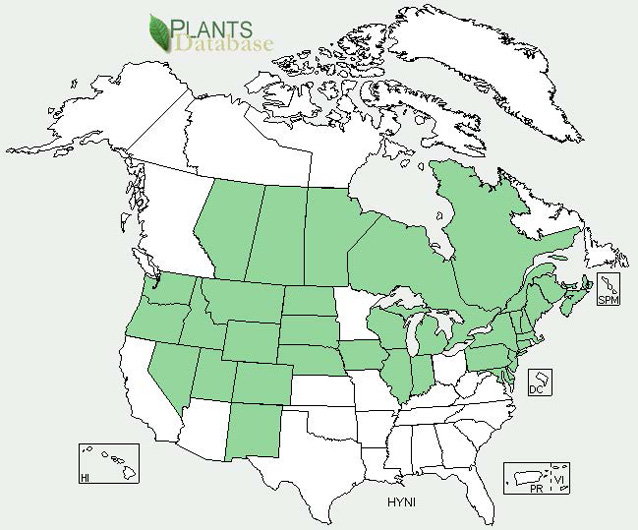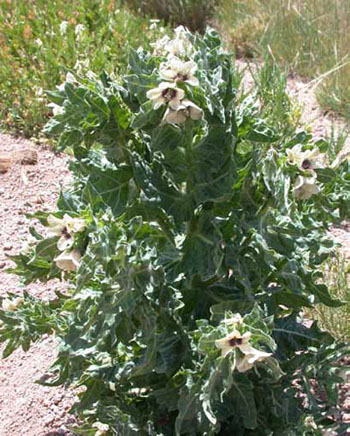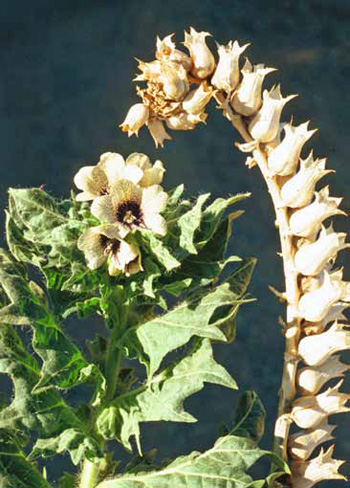Solanaceae (Nightshade family)
At a Glance

Mary Ellen (Mel) Harte / Bugwood.org
- Biennial or annual
- Foul-smelling foliage covered with sticky hairs.
- Leaves gray-green with conspicuous pale veins.
- Flowers occur both at the ends of the stems in long, leafy spikes and singly in the spaces between the leaves and the stem.
- Flowers are pale yellow with conspicuous purple veins and a purple throat. Bases are densely covered with long, glandular hairs.
- Fruit is a capsule that is concealed from view by the sepals.
- All plant parts are toxic to livestock and humans when ingested.
Habitat and Ecology
Native to Europe, black henbane (Hyoscyamus niger) now occurs across the Northeast, the Midwest, and much of the West. It was originally brought to the east coast for cultivation as a medicinal herb. Now it invades disturbed open sites, roadsides, fields, waste places, and abandoned gardens. Black henbane grows best in sandy or well-drained loamy soils with moderate fertility. It does not tolerate water-logged soils. A member of the nightshade family, black henbane is poisonous to humans and livestock when ingested.
Distribution Map

USDA
Description

Mary Ellen (Mel) Harte / Bugwood.org
Black henbane is a biennial or an annual herb with foulsmelling foliage covered with sticky hairs. Its leafy stems grow to three feet tall. The biennial form first develops a rosette for a growing season before producing stems. The stems of the biennial form have many branches, but the stems of the annual form have only a few branches. Both annuals and biennials have a thick and fleshy taproot. Black henbane reproduces by seeds that can remain viable in the soil for up to five years.
Leaves
The leaves of the basal rosette are alternate and often have stalks almost as long as the blades. The stem leaves are alternate, shallowly lobed, and gray-green with conspicuous pale veins. Covered with short, sticky hairs, the leaves have a foul odor.

© Steve Dewey / Utah State University
Flowers and Fruits
The flowers occur both at the ends of the stems in long, leafy spikes and singly in the spaces between the leaves and the stem. Each flower is composed of sepals fused into an urn shape and petals fused into a funnel shape with unequal lobes. The flowers are pale yellow with conspicuous purple veins and a purple throat. At their bases, the flowers are densely covered with long, glandular hairs. Black henbane flowers June through September, but the annuals tend to bloom later in the season than the biennials.
The fruit is an egg-shaped capsule, or a dry fruit composed of more than one carpel that opens at maturity. The fruits are about one inch long, with hundreds of tiny seeds. The fused sepals loosely enclose the fruit and conceal it from view.
Etymology
Hyoscyamine is one of the alkaloid chemicals found in this plant.
Ethnobotany
Black henbane has been used medicinally for centuries and is currently commercially cultivated for its alkaloid compounds. All plant parts contain tropane alkaloids, which are toxic to humans and animals when ingested.
Control Methods
Possible control methods are explained at these websites:
References
California Department of Food and Agriculture. No date. Black henbane in Encycloweedia. Available at https://www.cdfa.ca.gov/plant/ipc/encycloweedia/weedinfo/hyoscyamus-niger.htm (accessed 1 April 2010).
Colorado Department of Agriculture. 2008. Black henbane. Conservation Services Division, Lakewood, CO. (accessed 1 April 2010).
Graham, J., and W. S. Johnson. No date. Managing black henbane. University of Nevada Cooperative Extension, Reno, NV. Available at http://www.unce.unr.edu/publications/files/nr/2004/FS0410.pdf (accessed 1 April 2010).
North Dakota Department of Agriculture. No data. Black henbane. (accessed 1 April 2010).
Prepared by Kelly Reeves, Southern Colorado Plateau Network Inventory and Monitoring Program, 2010.
Last updated: May 26, 2016
